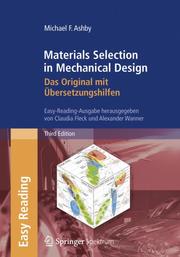-
Zusatztext
-
Inhaltsangabe1 Introduction 1.1 Introduction and synopsis 1.2 Materials in design 1.3 The evolution of engineering materials 1.4 Case study: the evolution of materials in vacuum cleaners 1.5 Summary and conclusions 1.6 Further reading 2 The design process 2.1 Introduction and synopsis 2.2 The design process 2.3 Types of design 2.4 Design tools and materials data 2.5 Function, material, shape, and process 2.6 Case study: devices to open corked bottles 2.7 Summary and conclusions 2.8 Further reading 3 Engineering materials and their properties 3.1 Introduction and synopsis 3.2 The families of engineering materials 3.3 The definitions of material properties 3.4 Summary and conclusions 3.5 Further reading 4 Material property charts 4.1 Introduction and synopsis 4.2 Exploring material properties 4.3 The material property charts 4.4 Summary and conclusions 4.5 Further reading 5 Materials selection¿the basics 5.1 Introduction and synopsis 5.2 The selection strategy 5.3 Attribute limits and material indices 5.4 The selection procedure 5.5 Computeraided selection 5.6 The structural index 5.7 Summary and conclusions 5.8 Further reading 6 Materials selection¿case studies 6.1 Introduction and synopsis 6.2 Materials for oars 6.3 Mirrors for large telescopes 6.4 Materials for table legs 6.5 Cost: structural material for buildings 6.6 Materials for flywheels 6.7 Materials for springs 6.8 Elastic hinges and couplings 6.9 Materials for seals 6.10 Deflection-limited design with brittle polymers 6.11 Safe pressure vessels 6.12 Stiff, high damping materials for shaker tables 6.13 Insulation for short-term isothermal containers 6.14 Energyefficient kiln walls 6.15 Materials for passive solar heating 6.16 Materials to minimize thermal distortion in precision devices 6.17 Nylon bearings for ships¿ rudders 6.18 Materials for heat exchangers 6.19 Materials for radomes 6.20 Summary and conclusions 6.21 Further reading 7 Processes and process selection 7.1 Introduction and synopsis 7.2 Classifying processes 7.3 The processes: shaping, joining, and finishing 7.4 Systematic process selection 7.5 Ranking: process cost 7.6 Computeraided process selection 7.7 Supporting information 7.8 Summary and conclusions 7.9 Further reading 8 Process selection case studies 8.1 Introduction and synopsis 8.2 Forming a fan 8.3 Fabricating a pressure vessel 8.4 An optical table 8.5 Economical casting 8.6 Computerbased selection: a manifold jacket 8.7 Computerbased selection: a sparkplug insulator 8.8 Summary and conclusions 9 Multiple constraints and objectives 9.1 Introduction and synopsi 9.2 Selection with multiple constraints 9.3 Conflicting objectives, penalty-functions, and exchange constants 9.4 Summary and conclusion 9.5 Further reading Appendix: Traditional methods of dealing with multiple constraints and objectives 10 Case studies¿multiple constraints and conflicting objectives 10.1 Introduction and synopsis 10.2 Multiple constraints: con-rods for high-performance engines 10.3 Multiple constraints: windings for high-field magnets 10.4 Conflicting objectives: casings for a mini-disk player 10.5 Conflicting objectives: materials for a disk-brake calipes 10.6 Summary and conclusions 11 Selection of material and shape 11.1 Introduction and synopsis 11.2 Shape factors 11.3 Microscopic or micro-structural shape factors 11.4 Limits to shape efficiency 11.5 Exploring and comparing structural sections 11.6 Material indices that include shape 11.7 Coselecting material and shape 11.8 Summary and conclusions 11.9 Further reading 12 Selection of material and shape: case studies 12.1 Introduction and synopsis 12.2 Spars for man-powered planes 12.3 Ultraefficient springs 12.4 Forks for a racing bicycle 12.5 Floor joists: wood, bamboo or steel? 12.6 Increasing the stiffness of steel sheet 12.7 Table legs again: thin or light? 12.8 Shapes that flex: lea
-
-
Kurztext
-
Spektrum Akademischer Verlag präsentiert hier das englischsprachige weltweit anerkannte Standardwerk zur Werkstoffauswahl, das als neuer Buchtyp speziell an die Bedürfnisse deutschsprachiger Leser angepasst wurde. Von Ingenieurinnen und Ingenieuren wird heute im Studium und Beruf erwartet, dass sie englische Literatur lesen und verstehen und in ihrem Fachgebiet auch auf Englisch kommunizieren können. Ein wesentlicher Zusatznutzen dieses Buches ist es, das Lesen und Lernen im englischen Original zu erleichtern und gleichzeitig in die spezielle Fachterminologie einzuführen: Es bietet Ihnen neben dem englischen Originaltext Übersetzungshilfen in der Randspalte zur Fachterminologie und zu schwierigen normalsprachlichen Ausdrücken ein zweisprachiges Fachwörterbuch zum raschen Nachschlagen und in Verbindung mit dem Index zum Auffinden von Textstellen ausgehend vom deutschen Stichwort ein um deutschsprachige Referenzen ergänztes Literaturverzeichnis Understanding materials, their properties and behaviour is fundamental to engineering design, and a key application of materials science. Written for all students of engineering, materials science and design, this book describes the procedures for material selection in mechanical design in order to ensure that the most suitable materials for a given application are identified from the full range of materials available. Key Features include: Fully revised throughout, with new material on topics including process selection, material and shape selection, design of hybrid materials, environmental factors and industrial design Readerfriendly approach and attractive, easy to use twocolour presentation Improved tutor resources with supporting online materials and Instructor's Manual Unique material selection charts available to download online The methods developed in the book are implemented in Granta Design's widely used CES Educational software Revised and expanded for this third edition, Materials Selection in Mechanical Design is recognised as a key text for materials properties courses internationally, and provides a unique and genuinely innovative resource for students and practicing engineers.
-
-
Autorenportrait
- Autor: Michael F. Ashby is Royal Society Research Professor at Cambridge University and Visiting Professor of Design at the Royal College of Art, London, UK. Herausgeber der deutschen Easy-Reading-Ausgabe: Alexander Wanner ist Professor für Werkstoffkunde an der Fakultät für Maschinenbau der Universität Karlsruhe (TH). Seine Lehr- und Forschungstätigkeit konzentriert sich auf metallische Legierungen, Ingenieurskeramiken und Verbundwerkstoffe - von den physikalischen Grundlagen bis zur industriellen Anwendung. Claudia Fleck ist Professorin für Werkstofftechnik an der Technischen Universität Berlin, wo sie Fragestellungen zum Ermüdungs- und Korrosionsverhalten metallischer Werkstoffe behandelt. Einen weiteren Schwerpunkt stellen medizinische Implantatwerkstoffe dar. Einen weiteren Schwerpunkt stellen medizinische Implantatwerkstoffe dar.
Detailansicht
Materials Selection in Mechanical Design: Das Original mit Übersetzungshilfen
Easy-Reading-Ausgabe
ISBN/EAN: 9783827417626
Umbreit-Nr.: 1159950
Sprache:
Englisch
Umfang: XVI, 648 S., 285 farbige Illustr.
Format in cm: 3.7 x 24 x 17
Einband:
kartoniertes Buch
Erschienen am 19.10.2006
Auflage: 3/2007


